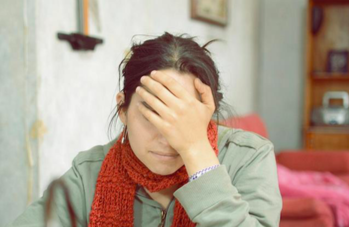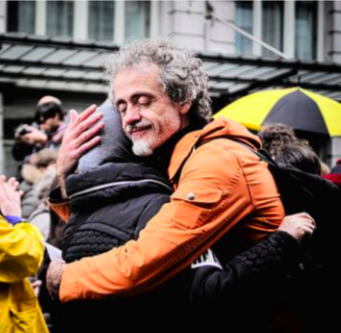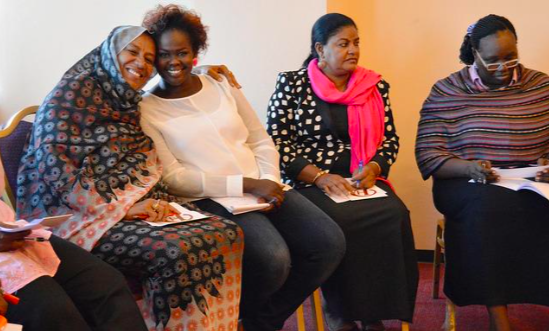14.1.10: Grief, Bereavement, and Mourning
- Last updated
- Save as PDF
- Page ID
- 63388
The terms grief, bereavement, and mourning are often used interchangeably, however, they have different meanings. Grief is the normal process of reacting to a loss. Grief can be in response to a physical loss, such as a death, or a social loss including a relationship or job. Bereavement is the period after a loss during which grief and mourning occurs. The time spent in bereavement for the loss of a loved one depends on the circumstances of the loss and the level of attachment to the person who died. Mourning is the process by which people adapt to a loss. Mourning is greatly influenced by cultural beliefs, practices, and rituals (Casarett, Kutner, & Abrahm, 2001).
Grief Reactions: Typical grief reactions involve mental, physical, social and/or emotional responses. These reactions can include feelings of numbness, anger, guilt, anxiety, sadness and despair. The individual can experience difficulty concentrating, sleep and eating problems, loss of interest in pleasurable activities, physical problems, and even illness. Research has demonstrated that the immune systems of individuals grieving is suppressed and their healthy cells behave more sluggishly, resulting in greater susceptibility to illnesses (Parkes & Prigerson, 2010). However, the intensity and duration of typical grief symptoms do not match those usually seen in severe grief reactions, and symptoms typically diminish within 6-10 weeks (Youdin, 2016).

Complicated Grief: After the loss of a loved one, however, some individuals experience complicated grief, which includes atypical grief reactions (Newson, Boelen, Hek, Hofman, & Tiemeier, 2011). Symptoms of complicated grief include: Feelings of disbelief, a preoccupation with the dead loved one, distressful memories, feeling unable to move on with one’s life, and a yearning for the deceased. Additionally, these symptoms may last six months or longer and mirror those seen in major depressive disorder (Youdin, 2016).
According to the Diagnostic and Statistical Manual of Mental Disorders (5th ed.; American Psychiatric Association, 2013), distinguishing between major depressive disorder and complicated grief requires clinical judgment. The psychologist needs to evaluate the client’s individual history and determine whether the symptoms are focused entirely on the loss of the loved one and represent the individual’s cultural norms for grieving, which would be acceptable. Those who seek assistance for complicated grief usually have experienced traumatic forms of bereavement, such as unexpected, multiple and violent deaths, or those due to murders or suicides (Parkes & Prigerson, 2010).
Disenfranchised Grief: Grief that is not socially recognized is referred to as disenfranchised grief (Doka, 1989). Examples of disenfranchised grief include death due to AIDS, the suicide of a loved one, perinatal deaths, abortions, the death of a pet, lover, or ex-spouse, and psychological losses, such as a partner developing Alzheimer’s disease. Due to the type of loss, there is no formal mourning practices or recognition by others that would comfort the grieving individual. Consequently, individuals experiencing disenfranchised grief may suffer intensified symptoms due to the lack of social support (Parkes & Prigerson, 2010).
Anticipatory Grief: Grief that occurs when a death is expected and survivors have time to prepare to some extent before the loss is referred to as anticipatory grief. This expectation can make adjustment after a loss somewhat easier (Kübler-Ross & Kessler, 2005). A death after a long-term, painful illness may bring family members a sense of relief that the suffering is over, and the exhausting process of caring for someone who is ill is also completed.
Models of Grief
There are several theoretical models of grief, however, none is all encompassing (Youdin, 2016). These models are merely guidelines for what an individual may experience while grieving. However, if individuals do not fit a model, it does not mean there is something “wrong” with the way they experience grief. It is important to remember that there is no one way to grieve, and people move through a variety of stages of grief in various ways.
Five Stages of Grief: Kübler-Ross (1969, 1975) describes five stages of loss experienced by someone who faces the news of their impending death. These "stages" are not really stages that a person goes through in order or only once; nor are they stages that occur with the same
intensity. Indeed, the process of death is influenced by a person's life experiences, the timing of their death in relation to life events, the predictability of their death based on health or illness, their belief system, and their assessment of the quality of their own life. Nevertheless, these stages help us to understand and recognize some of what a dying person experiences psychologically, and by understanding, we are more equipped to support that person as they die.
- Denial is often the first reaction to overwhelming, unimaginable news. Denial, or disbelief or shock, protects us by allowing such news to enter slowly and to give us time to come to grips with what is taking place. The person who receives positive test results for life-threatening conditions may question the results, seek second opinions, or may simply feel a sense of disbelief psychologically even though they know that the results are true.
- Anger also provides us with protection in that being angry energizes us to fight against something and gives structure to a situation that may be thrusting us into the unknown. It is much easier to be angry than to be sad, in pain, or depressed. It helps us to temporarily believe that we have a sense of control over our future and to feel that we have at least expressed our rage about how unfair life can be. Anger can be focused on a person, a health care provider, at God, or at the world in general. It can be expressed over issues that have nothing to do with our death; consequently, being in this stage of loss is not always obvious.
- Bargaining involves trying to think of what could be done to turn the situation around. Living better, devoting self to a cause, being a better friend, parent, or spouse, are all agreements one might willingly commit to if doing so would lengthen life. Asking to just live long enough to witness a family event or finish a task are examples of bargaining.
- Depression or sadness is appropriate for such an event. Feeling the full weight of loss, crying, and losing interest in the outside world is an important part of the process of dying. This depression makes others feel very uncomfortable and family members may try to console their loved one. Sometimes hospice care may include the use of antidepressants to reduce depression during this stage.
- Acceptance involves learning how to carry on and to incorporate this aspect of the life span into daily existence. Reaching acceptance does not in any way imply that people who are dying are happy about it or content with it. It means that they are facing it and continuing to make arrangements and to say what they wish to say to others. Some terminally ill people find that they live life more fully than ever before after they come to this stage.
According to Kübler-Ross (1969), behind these five stages focused on the identified emotions, there is a sense of hope. Kübler-Ross noted that in all the 200 plus patients she and her students interviewed, a little bit of hope that they might not die was always in the back of their minds.
Criticisms of Kübler-Ross’s Five Stages of Grief: Some researchers have been skeptical of the validity of there being stages to grief among the dying (Friedman & James, 2008). As Kübler- Ross notes in her own work, it is difficult to empirically test the experiences of the dying. “How do you do research on dying,...? When you cannot verify your data and cannot set up experiments?” (Kübler-Ross, 1969, p. 19). She and four students from the Chicago Theology Seminary in 1965 decided to listen to the experiences of dying patients, but her ideas about death and dying are based on the interviewers’ collective “feelings” about what the dying were experiencing and needed (Kübler-Ross, 1969). While she goes on to say in support of her approach that she and her students read nothing about the prior literature on death and dying, so as to have no preconceived ideas, a later work revealed that her own experiences of grief from childhood undoubtedly colored her perceptions of the grieving process (Kübler-Ross & Kessler, 2005). Kübler-Ross is adamant in her theory that the one stage that all those who are dying go through is anger. It is clear from her 2005 book that anger played a central role in “her” grief, and did so for many years (Friedman & James, 2008).
There have been challenges to the notion that denial and acceptance are beneficial to the grieving process (Telford, Kralik, & Koch, 2006). Denial can become a barrier between the patient and health care specialists, and reduce the ability to educate and treat the patient. Similarly, acceptance of a terminal diagnosis may also lead patients to give up and forgo treatments to alleviate their symptoms. In fact, some research suggests that optimism about one’s prognosis may help in one’s adjustment and increase longevity (Taylor, Kemeny, Reed, Bower & Gruenewald, 2000).
A third criticism is not so much of Kübler-Ross’s work, but how others have assumed that these stages apply to anyone who is grieving. Her research focused only on those who were terminally ill. This does not mean that others who are grieving the loss of someone would necessarily experience grief in the same way. Friedman and James (2008) and Telford et al. (2006) expressed concern that mental health professionals, along with the general public, may assume that grief follows a set pattern, which may create more harm than good.
Lastly, the Yale Bereavement Study, completed between January 2000 and January 2003, did not find support for Kübler-Ross’s five stage theory of grief (Maciejewski, Zhang, Block, & Prigerson, 2007). Results indicated that acceptance was the most commonly reported reaction from the start, and yearning was the most common negative feature for the first two years. The other variables, such as disbelief, depression, and anger, were typically absent or minimal.
Although there is criticism of the Five Stages of Grief Model, Kübler-Ross made people more aware of the needs and concerns of the dying, especially those who were terminally ill. As she notes,
...when a patient is severely ill, he is often treated like a person with no right to an opinion. It is often someone else who makes the decision if and when and where a patient should be hospitalized. It would take so little to remember that the sick person has feelings, has wishes and opinions, and has – most important of all – the right to be heard. (1969, p. 7-8).
Dual-Process Model of Grieving: The dual-process model takes into consideration that bereaved individuals move back and forth between grieving and preparing for life without their loved one (Stroebe & Schut, 2001; Stroebe, Schut, & Stroebe, 2005). This model focuses on a loss orientation, which emphasizes the feelings of loss and yearning for the deceased and a restoration orientation, which centers on the grieving individual reestablishing roles and activities they had prior to the death of their loved one. When oriented toward loss grieving individuals look back, and when oriented toward restoration they look forward. As one cannot look both back and forward at the same time, a bereaved person must shift back and forth between the two. Both orientations facilitate normal grieving and interact until bereavement has completed.
Grief: Loss of Children and Parents
Loss of a Child: According to Parkes and Prigerson (2010), the loss of a child at any age is considered “the most distressing and long-lasting of all griefs” (p. 142). Bereaved parents suffer an increased risk to both physical and mental health and exhibit an increased mortality rate. Additionally, they earn higher scores on inventories of grief compared to other types of bereavement. Of those recently diagnosed with depression, a high percentage had experienced the death of child within the preceding six months, and 8 percent of women whose child had died attempted or committed suicide. Archer (1999) found that the intensity of grief increased with the child’s age until the age of 17, when it declined. Archer explained that women have a greater chance of having another child when younger, and thus with added age comes greater grief as fertility declines. Certainly, the older the child the more the mother has bonded with the child and will experience greater grief.
Even when children are adults, parents may experience intense grief, especially when the death is sudden. Adult children dying in traffic accidents was associated with parents experiencing more intense grief and depression, greater symptoms on a health check list, and more guilt than those parents whose adult children died from cancer (Parkes & Prigerson, 2010). Additionally, the deaths of unmarried adult children still residing at home and those who experienced alcohol and relationship problems were especially difficult for parents. Overall, in societies in which childhood deaths are statistically infrequent, parents are often unprepared for the loss of their daughter or son and suffer high levels of grief.

Loss of Parents in Adulthood: In contrast to the loss of a child, the loss of parents in adult life is much more common and results in less suffering. In their literature review, Moss and Moss (1995) found that the loss of a parent in adult life is “rarely pathological.” Those adult children who appear to have the most difficulty dealing with the loss of a parent are adult men who remain unmarried and continue to live with their mothers. In contrast, those who are in satisfying marriages are less likely to require grief assistance (Parkes & Prigerson, 2010). To determine the effects of gender on parental death, Marks, Jun and Song (2007) analyzed longitudinal data from the National Survey of Families and Households that assessed multiple dimensions of psychological well-being in adulthood including depression, happiness, self-esteem, mastery, psychological wellness, alcohol abuse, and physical health. Findings indicated that a father’s death led to more negative effects for sons than daughters, and a mother’s death lead to more negative effects for daughters.

Loss of Parents in Childhood: Parental deaths in childhood have been associated with adjustment problems that may last into adulthood. Ellis, Dowrick and Lloyd-Williams (2013) identified several negative outcomes associated with childhood grief including increased chance of substance abuse, greater susceptibility to depression, higher chance of criminal behavior, school underachievement, and lower employment rates. Typically, professional help is not required in helping children and teens who are dealing with the death of a loved one. However, Worden (2002) identified ten “red flags” displayed by grieving children that may indicate the need for professional assistance:
- Persistent difficulty in talking about the dead person
- Persistent or destructive aggressive behavior
- Persisting anxiety, clinging, or fears
- Somatic complaints (stomachaches, headaches)
- Sleeping difficulties
- Eating disturbance
- Marked social withdrawal
- School difficulties or serious academic reversal
- Persistent self-blame or guilt
- Self-destructive behavior
As parents may also be dealing with funeral arrangements and other end of life matters, they may not always have the time to address questions and concerns that children may have. When explaining death to children it is important to use real words, such as died and death (Dresser & Wasserman, 2010). Children do not understand the meanings of such phrases as “passed away”, “left us”, or “lost”, and they can become confused as to what happened. Saying a loved one died of a disease called cancer, is preferable to saying he was “very sick”. The child may become worried when others become sick that they too will die. Consequently, it is important that children have someone who will listen to, and accurately address their concerns.
Mourning
As a society, are we given the tools and time to adequately mourn? Not all researchers agree that we do. The "death-denying, grief-dismissing world" is the modern world (Kübler-Ross & Kessler, 2005, p. 205). We often grieve privately, quickly, and medicate our suffering with substances or activities. Employers grant 3 to 5 days for bereavement, if the loss is that of an immediate family member, and such leaves are sometimes limited to no more than one per year. Yet grief takes much longer and the bereaved are seldom ready to perform well on the job after just a few days. Obviously life does have to continue, but we need to acknowledge and make more caring accommodations for those who are in grief.
Four Tasks of Mourning: Worden (2008) identified four tasks that facilitate the mourning process. Worden believes that all four tasks must be completed, but they may be completed in any order and for varying amounts of time. These tasks include:
- Acceptance that the loss has occurred
- Working through the pain of grief
- Adjusting to life without the deceased
- Starting a new life while still maintaining a connection with the deceased

Support Groups: Support groups are helpful for grieving individuals of all ages, including those who are sick, terminal, caregiving, or mourning the loss of a loved one. Support groups reduce isolation, connect individuals with others who have similar experiences, and offer those grieving a place to share their pain and learn new ways of coping (Lynn & Harrold, 2011). Support groups are available through religious organizations, hospitals, hospice, nursing homes, mental health facilities, and schools for children.
Viewing death as an integral part of the lifespan will benefit those who are ill, those who are bereaved, and all of us as friends, caregivers, partners, family members and humans in a global society.


